Planting perennial roots has its advantages. It can also stir up some confusion on how to plant bare-root perennials. Planting perennials from bare roots is wise. They often grow as more resilient plants due to not being grown in a greenhouse, or having treatments done to manipulate their growth and bloom patterns. The price is more appealing than buying started plants from a garden center. Expanded varieties are also often available when purchasing perennial roots.
Bare-root perennial root structures and how to plant them can bring up some questions and confusion. Each perennial is different and there may always be a learning curve. Don’t worry! We have specific instructions for some of the most popular bare-root perennials and how to plant them.
Popular Perennials Planted from Roots
If you are brand new to planting perennials from roots, start with this helpful How to Plant Bare Root Perennial blog post. It will help you learn what a bare root is, how to store bare root perennials and general planting tips. The aim of this How to Guide is to provide details of specific spring planted bare root perennials that are commonly sold as perennial roots.
Planting Tips that Apply to All Bare Root Perennials
Whether you are planting the roots directly into the ground or into pots follow these general tips. Make sure the roots will fit into the area you are planting them, whether it is a pot or in the ground. If planting directly in the ground dig the hole 2 times wider than the roots. For example, if the roots are 2-3″ wide dig a hole 4-6″ across.
Backfill with soil around the roots. Add water after planting to allow for soil setting. Add additional soil once it has settled so the roots are covered. However, make sure the crown is not buried after adding additional soil.
It is common for some new growth to be emerging in the package. The new growth may be white, which is completely normal, as the leaves have not been exposed to sunlight which is what creates the pigment.
It is better if the crown of the root is planted too high vs too deep. If you are unable to tell exactly where the crown is, plant the root slightly above the soil surface.
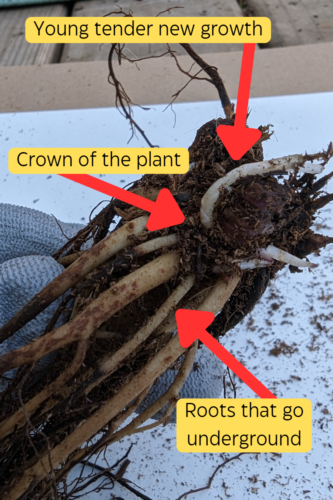
Bare Root Echinacea
How to Plant Bare Root Echinacea
Echinacea, also known as Coneflower, are popular summer blooming perennials. Echinacea is available in purple, pink, white, orange, yellow, red, and even green. The most popular variety of coneflower is Magnus Purple Coneflower and is commonly planted as a perennial root.
Locate the crown of the plant. The roots are below, they will be spread out in the ground. New tender growth may be visible, but not always.
Place the coneflower root so that the crown of the plant is at or slightly above the soil level. If the crown of the plant is too deep this can lead to rotting.
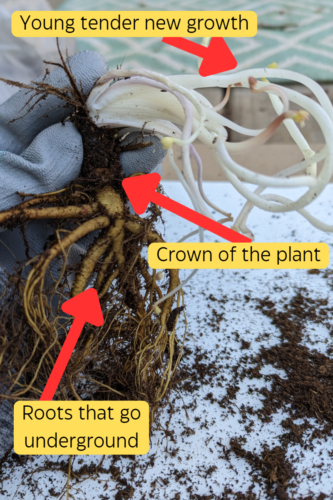
Bare Root Perennial Columbine
How to Plant Bare Root Columbine
Columbine are dainty spring-blooming perennials. They are loved for their intricate blooms. Columbine grows best in partial shade and soil that is moist but drains well.
For the best results start bare root columbine in pots. While they can be planted directly into the ground, their delicate new growth and roots often benefit from the controlled environment of container planting.
When you are ready to plant first locate the crown of the plant. The crown is where new growth or small sprouts emerge from. Place the crown of the plant at the soil level or slightly above with the roots buried underground in the planting hole or pot. Backfill with soil and water.
How to Plant Bare Root Veronica
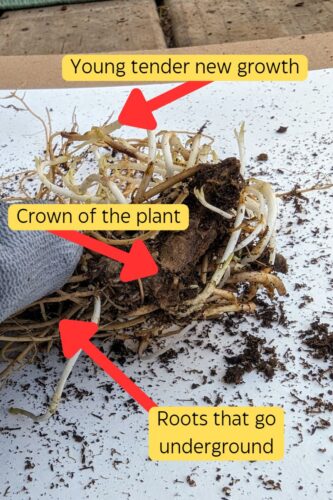
Bare Root Perennial Veronica
These hardy long blooming perennials are grown for their vibrant spike-shaped blooms. Veronica has a neat and tidy appearance, with vivid blue, purple, pink, or white flowers in early summer.
Veronica can be planted directly in the ground or started in pots. Their root systems are typically large enough that planting directly into the ground will work for them. However, starting your perennial roots in pots is always the safest and easiest method.
The roots of veronica are narrow and abundant. The crown of the plant may have new sprouts and growth emerging from it. You should be able to clearly see where the roots start at the crown as a secondary way to identify where the crown is. As always plant the crown at or slightly above the soil level.
How to Plant Bare Root Bleeding Hearts
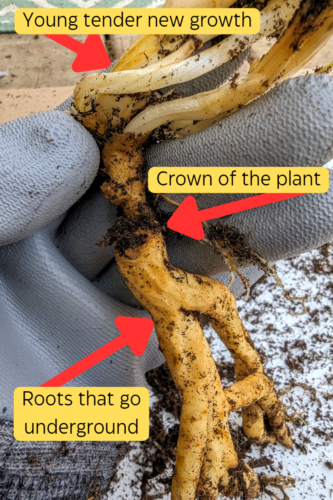
Bleeding Hearts
One of the more common perennials that is grown from a root is bleeding hearts. These reliable perennials thrive in a shade-to-part-shade environment. They bloom in mid-spring among the classic spring bulbs like tulips and daffodils.
Plant bleeding heart roots directly into the ground in spring or early summer. Make the planting hole 6-8″ in diameter and deep enough to fit the entire root.
The crown is fairly easy to identify as there is a noticeable difference between the large main roots and new growth. The crown is in between those, and often small fibrous roots, as well as growth nodes, will be present
How to Plant Bare Root Butterfly Weed
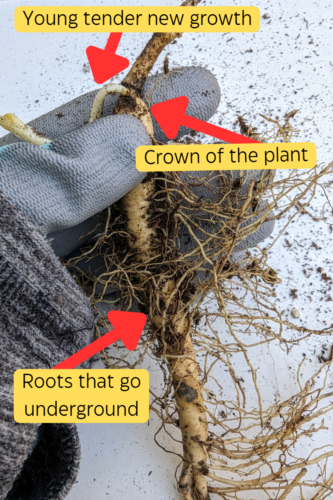
Butterfly Weed
One of if not the BEST perennials for attracting butterflies is Butterfly Weed. It blooms in early summer with a profusion of orange blooms.
The root of the butterfly weed has a carrot-like appearance with one main root and several fibrous roots that come from the main root.
Upon receiving this root it may or may not have growth coming from the top. However, the crown is usually easy to recognize as last year’s stem may be present. If growth is present it will come out from the crown. Plant the root directly in the ground or in a pot that is deep enough to fit the entire root. The crown should be at or above the soil level at the time of planting.
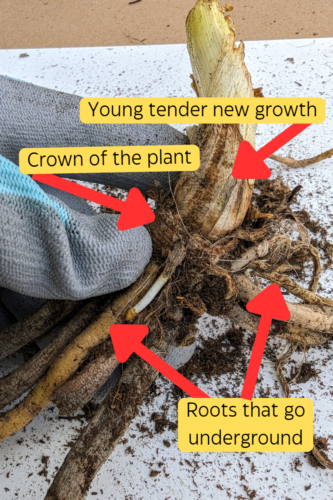
How to Plant Bare Root Daylilies
One of the most popular perennials in general, but also one of the most popular perennials to grow from a bare root. They are easy to grow and many varieties of daylilies bloom for weeks to months in summer.
Daylilies have a robust enough root system to plant directly into the ground. Dig the hole 6-12″ wide depending on the size of the root.
Most likely the daylily will have some top growth upon arrival. The crown is located slightly below where this growth is coming from. Place the crown at or above the soil surface when planting. Spread the roots out in the planting hole.
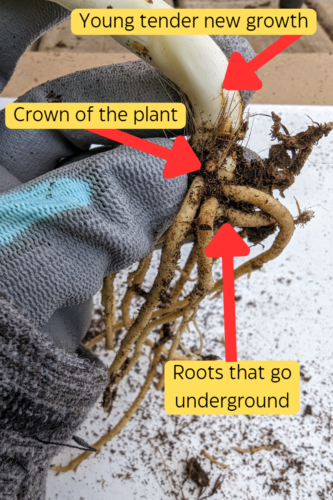
How to Plant Bare Root Hosta
Similar to daylilies, hosta are popular, easy to grow, and often planted as bare roots. However, hostas thrive in the shade and are the top perennial for a mixed-shade garden.
Plant bare root hosta directly in the ground. But, know that starting your hosta plants from roots in pots is certainly acceptable as well.
New growth will most likely be present and emerging from the crown of the plant. Dig a hole large enough to spread the roots out and place the crown of the plant at soil level or slightly above. Add soil below the roots if the crown appears to be too deep when positioning it in the planting location.
How to Plant Bare Root Black Eyed Susan 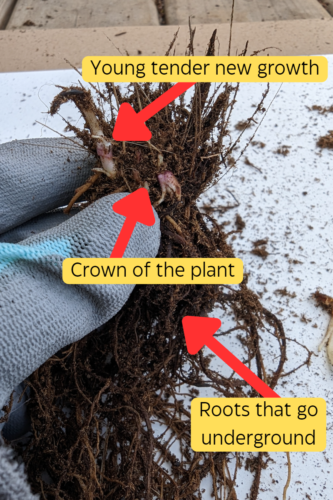
One of the top perennials for mid-to-late summer color. Black Eyed Susan are easy to grow and bloom for weeks in summer.
For the best planting success start Black Eyed Susan in pots. After a few weeks when growth can be seen transplant to the garden.
Black Eyed Susan may have some growth and new shoots showing, but not always. Therefore, the crown can be located at the top of the cluster of roots. It will feel solid. Find a container that is large enough to fit all the roots. Add soil to the bottom couple of inches of the pot. Place the root in the pot and add soil up to the crown of the plant. If the soil settles after watering you may need to add more soil to make sure the roots aren’t exposed.
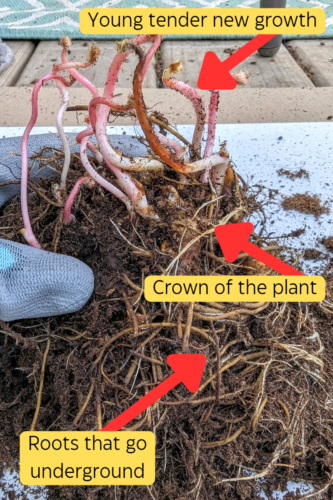
How to Plant Bare Root Astilbe
Astilbe are long-lived perennials that grow well in the shade. When astilbe are established in the garden they are quite easy to grow. However, they do not like dry soil or roots, and it is important that they receive adequate water.
Planting astilbe from roots will be more successful when they are started in a pot first. This will help to ensure the astilbe is not drying out and gets enough water.
The growth will come out of multiple points of the crown. Where the roots end and the crown starts can be difficult to pinpoint exactly. However, they most likely will have new growth emerging, which will tell you where the crown is. If you are unsure plant the mass of roots so that the top growth is 1/4″-1/2″ above the soil level.
A Start to Planting Perennial Roots
This guide is just the start of learning the proper way to plant perennial roots. Hopefully, the pictures of the roots will help to identify where the crown is, where the roots are, and what to do with the new growth. If there is one takeaway from this guide it is always best to have the crown at or slightly above the soil level.
Are there any bare-root perennials or flower bulbs you need specific instructions on? If the answer is yes, contact me at jenny@bulbblog.com, and I can help to ensure your success!


